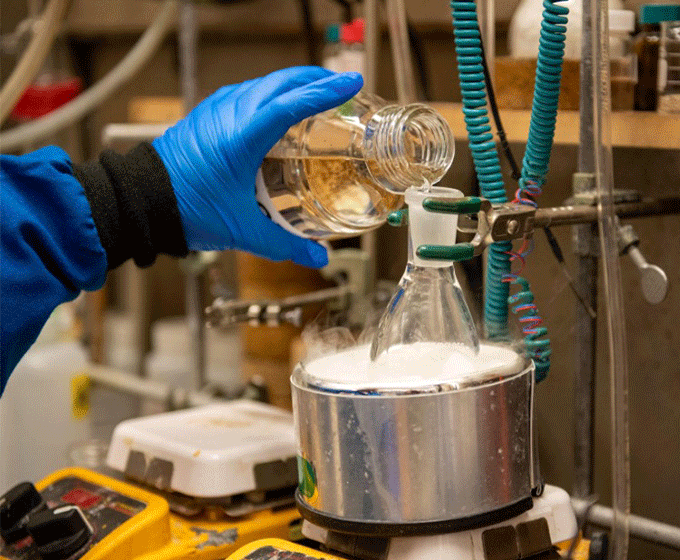
SwRI senior research scientist Shawn Blumberg and UTSA chemistry professor Doug Frantz have developed a method to synthesize highly potent derivatives of the antimalarial drug artemisinin, which could lead to a more cost-effective treatment for deadly disease.
MAY 2, 2023 — Southwest Research Institute (SwRI) and UTSA have developed a method to synthesize the highly potent antimalarial drug artemisinin, which could lead to a more cost-effective treatment for malaria. The work, recently featured on the cover of the scientific journal Organic Letters, was supported by the Bill and Melinda Gates Foundation as well as a grant from the Connecting through Research Partnerships (Connect) program, a joint effort by UTSA and SwRI to enhance scientific collaboration between the two institutions.
In 2021, 247 million cases of malaria led to 619,000 deaths worldwide. The most effective malaria treatments utilize the drug artemisinin, which is derived from the sweet wormwood plant, Artemisia annua. However, the process of isolating artemisinin from the plant is time-consuming, and crop yields are susceptible to weather patterns, insect pests and other factors. Despite scientific advancements in treatment methods, the cost of artemisinin still burdens the countries most affected by malaria.
“We were able to develop a novel way of synthesizing artemisinin that mimics how it’s made in nature,” said Shawn Blumberg of SwRI’s Chemistry and Chemical Engineering Division. “Our method mimics the biosynthetic pathway of how artemisinin is made in the plant where it originates, Artemisia annua. We studied the intermediate compounds along that pathway and then used chemistry to create those same intermediates and recreate the pathway.”
In 2020, Blumberg and UTSA chemistry professor Doug Frantz received a $125,000 grant from the Connect program to build on work supported by the Bill and Melinda Gates Foundation to create a more cost-effective way to synthesize artemisinin.
“There was nothing in public scientific literature that suggested this would work,” Frantz said. “This was challenging chemistry that we were trying to pull off, but we let science tell us where to go. It enabled us to design a process of taking a common intermediate in the biosynthetic pathway for artemisinin and converting it all the way to Artemisinic acid, which is the direct precursor to artemisinin.”
Blumberg and Frantz hope drug companies will take advantage of their work and offer a more potent and cost-effective malaria treatment to the impoverished countries that need it the most, especially considering the inherent risks of drought, wildfire and insects that come with depending on a plant that can only grow in certain parts of the world.
“The supply of artemisinin is still kind of erratic, which causes prices to be erratic as well, and countries dealing with this endemic need a stable, cost-effective solution,” Blumberg said. “While the new process we’ve created might not completely supplant current methods, it can complement other approaches and help to stabilize the world’s supply of artemisinin.”
SwRI’s Executive Office and UTSA’s Office of the Vice President for Research, Economic Development, and Knowledge Enterprise sponsor the collaborative Connect program, which offers grant opportunities to enhance greater scientific collaboration between the two institutions.
UTSA Today is produced by University Communications and Marketing, the official news source of The University of Texas at San Antonio. Send your feedback to news@utsa.edu. Keep up-to-date on UTSA news by visiting UTSA Today. Connect with UTSA online at Facebook, Twitter, Youtube and Instagram.
Move In To COLFA is strongly recommended for new students in COLFA. It gives you the chance to learn about the Student Success Center, campus resources and meet new friends!
Academic Classroom: Lecture Hall (MH 2.01.10,) McKinney Humanities BldgWe invite you to join us for Birds Up! Downtown, an exciting welcome back event designed to connect students with the different departments at the Downtown Campus. Students will have the opportunity to learn about some of the departments on campus, gain access to different resources, and collect some giveaways!
Bill Miller PlazaJoin us for an intimate evening of cocktails, conversation, and culinary inspiration with Pati Jinich, Emmy-nominated chef and James Beard Award-winning author. Enjoy light bites and signature drinks in the warm, modern setting of Mezquite as Pati connects with guests over her passion for Mexican cuisine and storytelling.
Mezquite Restaurant in Pullman Market, 221 Newell Ave., San Antonio 78215From inspired courses to thoughtful pairings and a rich sense of community, the Ven a Comer Signature Dinner is a night of shared meals, shared stories, and unforgettable flavor.
Stable Hall (Pear Brewery), 307 Pearl Pkwy, San Antonio 78215Come and celebrate this year's homecoming at the Downtown Campus with food, games, giveaways, music, and more. We look forward to seeing your Roadrunner Spirit!
Bill Miller PlazaThe University of Texas at San Antonio is dedicated to the advancement of knowledge through research and discovery, teaching and learning, community engagement and public service. As an institution of access and excellence, UTSA embraces multicultural traditions and serves as a center for intellectual and creative resources as well as a catalyst for socioeconomic development and the commercialization of intellectual property - for Texas, the nation and the world.
To be a premier public research university, providing access to educational excellence and preparing citizen leaders for the global environment.
We encourage an environment of dialogue and discovery, where integrity, excellence, respect, collaboration and innovation are fostered.